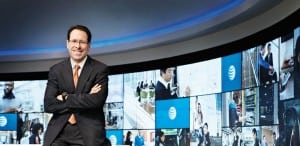AT&T Agrees to buy DirecTV
[Via Satellite 05-19-2014] On Sunday May 18, 2014, AT&T announced its entrance into a definitive agreement to purchase DirecTV. Rumors of the potential purchase came on the heels of, and effectively quelled, speculation that Dish would purchase the pay-TV giant. The total transaction is valued at $67.1 billion, including DirecTV’s net debt, and implies a total equity value of $48.5 billion. AT&T would pay $95 per share, based on AT&T’s Friday closing price.
The combined company would mark the creation of a new player in the ever-changing media landscape. AT&T made strides into satellite territory earlier this month after deciding to build an Air-to-Ground network that would compete with Gogo for connecting aircraft. For this service, AT&T’s land coverage would pair with satellite connectivity over oceans using Inmarsat’s Global Xpress satellite fleet. By purchasing DirecTV, AT&T will expand its reach most notably in video, but also in mobile and broadband networks.
“This is a unique opportunity that will redefine the video entertainment industry and create a company able to offer new bundles and deliver content to consumers across multiple screens — mobile devices, TVs, laptops, cars and even airplanes. At the same time, it creates immediate and long-term value for our shareholders,” said Randall Stephenson, chairman and CEO of AT&T. “DirecTV is the best option for us because they have the premier brand in pay-TV, the best content relationships, and a fast-growing Latin American business.”
DirecTV has more than 18 million subscribers in Latin America, including all of Sky Mexico’s customers. The company cites a large untapped pay-TV market coupled with a growing middle class, as part of the reason why Latin America is its fastest growing customer segment. In order to comply with regulatory procedures, AT&T stated it intends to divest all interests in America Movil, a Mexico City-based mobile network operator. The company will resign all its America Movil board of directors immediately.
Macquarie Telecom Analyst Kevin Smith believes this divestiture could spark even more mergers and acquisitions (M&A) activity in Latin America. No longer tethered to the U.S. telecom giant, America Movil could look to purchase Dish Mexico in order to accelerate its video strategy and monetize its portfolio of content.
“If [America Movil] (AMX) complies with the new regulations, a review panel could approve AMX for a broadcast license as early as Q4 of this year,” he said in a research note. “[Echostar] (SATS) management has recently stated that it would like to increase liquidity to bolster several growth initiatives and the sale of Dish Mexico could support this. We currently value Dish Mexico at approximately $1.5 billion and believe AMX could create approximately $1 billion in value through synergies within a few years.”
Stateside, the merger is subject to approval by AT&T shareholders, the U.S. Federal Communications Commission (FCC) and the U.S. Department of Justice. These regulatory bodies have noted the increase in media mergers, and are feeling pressure not to allow too much industry consolidation. Comcast’s ambition to buy Time Warner Cable, a deal that would create the largest cable company in the United States, is not far from focus.
AT&T expects the transaction for DirecTV to close in approximately 12 months. The company also foresees synergies greater than $1.6 billion on an annual run-rate basis within three years, driven primarily by increased scale in video. The combined company would make use of AT&T’s 2,300 retail stores and the thousands more authorized dealers and agents from both companies to offer bundled video and broadband services.
Stephenson said the transaction would bring high speed Internet to 15 million customers located mostly in rural areas AT&T currently does not service. Much of this service would use fiber along with fixed wireless local loop capabilities, but will not interfere with existing broadband expansion plans. Customers would have the option of purchasing broadband service as a stand-alone or as part of a bundle with other AT&T services. If standalone, the company aims to provide speeds of at least 6 Mbps where feasible, without raising prices for three years.
